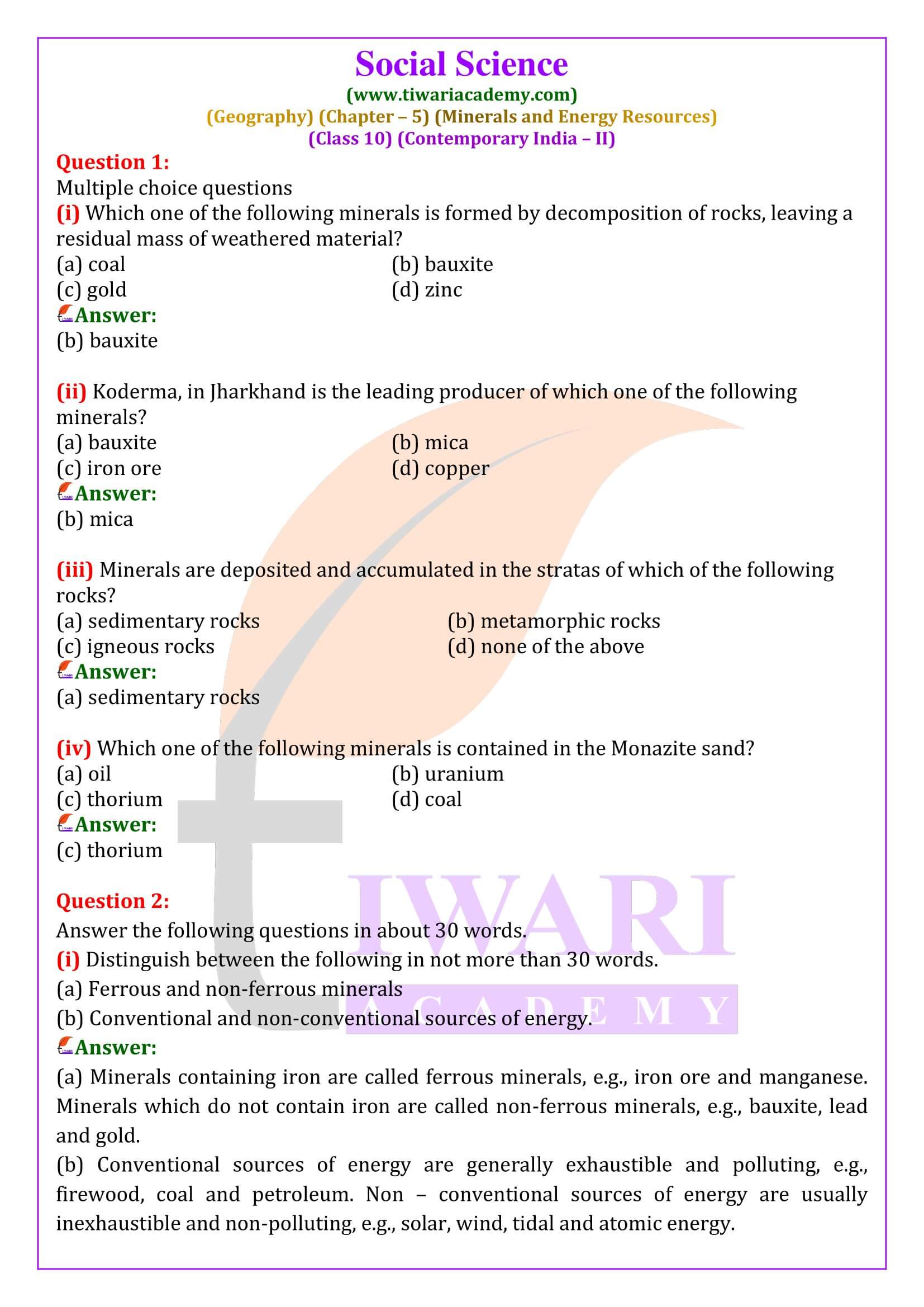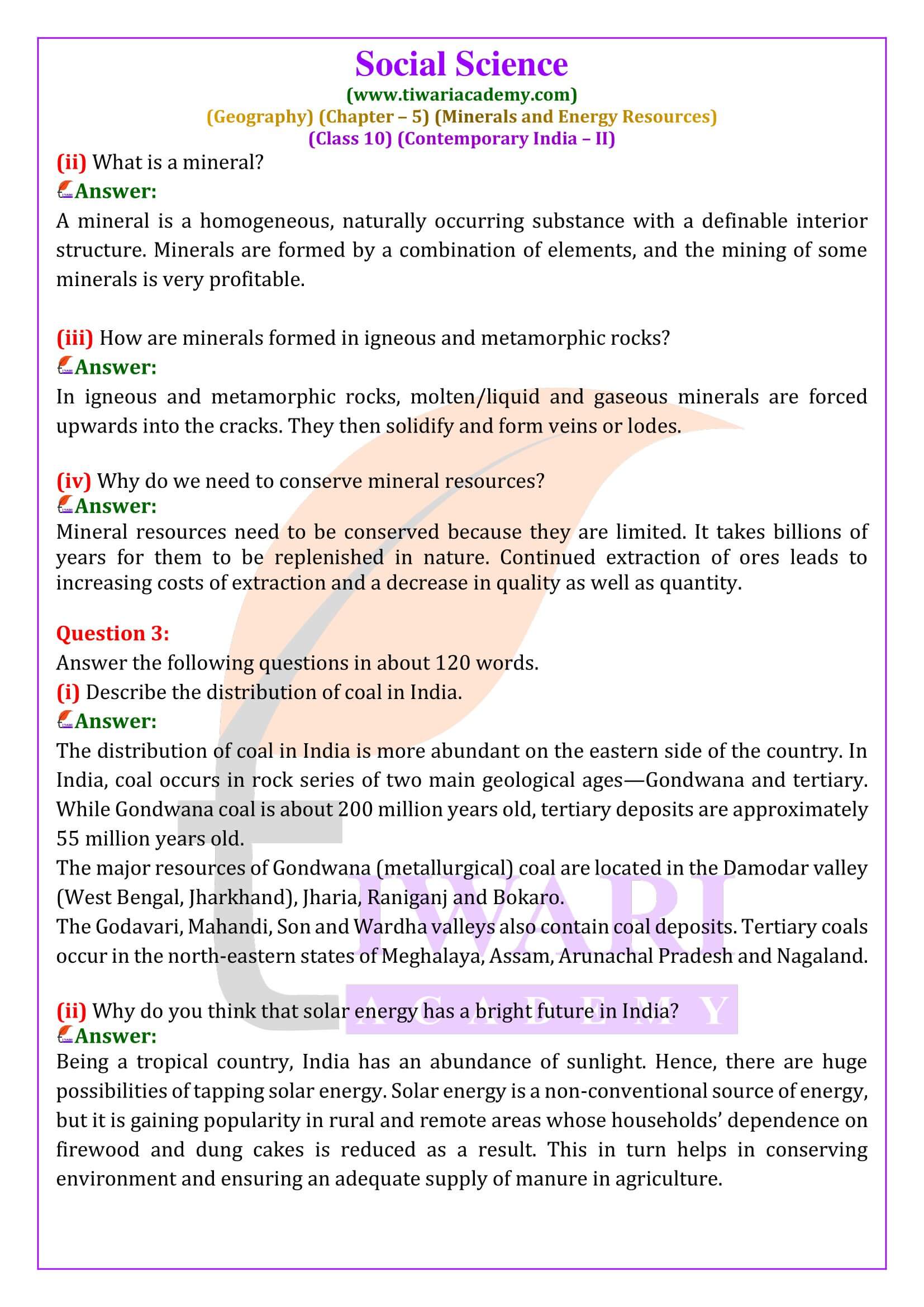NCERT Solutions for Class 10 Geography Chapter 5 Minerals and Energy Resources in Hindi and English Medium. We have updated all the contents and solutions for academic session 2025-26 based on latest CBSE Syllabus 2025-26. Download offline apps and study material for offline use. For any inconvenience, please call us or message us to resolve.
NCERT Solutions for Class 10 Geography Chapter 5 PDF
| Class: | 10 |
| Subject: | Social Science – Geography |
| Chapter 5: | Minerals and Energy Resources |
| Session: | 2025-26 |
Class 10 Geography Chapter 5 Minerals and Energy Resources
NCERT Solutions for Class 10 Geography Chapter 5 in PDF format free to download updated for new academic session 2025-26. Ask your doubts related to NCERT Books or other books also in Discussion Forum.
Exatra Questions Class 10 Geography Chapter 5
‘The future of Solar energy is bright in India.’ Why?
‘The future of Solar energy is bright in India because
(i) India is a tropical country.
(ii) It is a renewable resource.
(iii) Rural households can easily take its advantage.
What is meant by Minerals?
Homogenous, naturally occurring substance with a definable internal structure. It is an indispensable part of our lives. Almost everything we use are made from minerals.
How many types of minerals are there and how these are classified?
There are three types of minerals
(i) Metallic minerals
(ii) Non-Metallic minerals and
(iii) Energy minerals.
This classification is based on their colour, shine, hardness, density and crystallization.
What is an Ore?
Minerals are usually found in Ores. It is an accumulation of any mineral mixed with other elements. A mineral from which one can extract metal profitably is known as ore of that metal.
How minerals are formed in igneous and metamorphic rocks?
In igneous and metamorphic rocks minerals may occur in the cracks, faults and joints. The smaller occurrences are called veins and the larger are called lodes. In most cases they are formed when minerals in liquid / molten and gaseous forms are forced upward through cavities towards the earth’s surface. They cool and solidify as they rise. Major metallic minerals like tin, copper, zinc and lead etc. are obtained from veins and lodes.
How can we save or conserve energy?
(i) The electric switches should be off when not in use.
(ii) Public transport or pooling should be used.
(iii) As the conventional sources of energy are limited they should be used carefully.
(iv) Renewable resources should be used.
(v) The power saving instruments and devices should be used.
What is meant by a Geologist?
The person who study the formation of minerals their age and their physical and chemical composition is known as Geologist.
What are the four major iron ore belts of India?
There are four major iron ore belts in India.
1. Orissa-Jharkhand belt.
2. Maharashtra-Goa belt.
3. Bellary-Chitradurga-Chikmaglur-Tumkur belt.
4. Durg-Bastar-Chandrapur belt.
Important Terms on Class 10 Geography Chapter 5
Magnetite: The finest iron ore with a very high content of iron up to 70% 6. Petroleum – Impure or raw mineral oil which is the next major energy source in India after coal.
Hematite: The most important industrial iron ore in terms of the quantity used but has only 50-60% iron content.
Ferrous Minerals: Containing iron e.g. iron, manganese, nickel, cobalt etc.
Metallic Minerals: Minerals which have more metallic content e.g. iron ore, bauxite etc.
Non-Metallic Minerals – Minerals which have no metal portion e.g. lime stone, potash etc.
Nuclear Minerals: The matters which consists the nuclear power such as Uranium, Thorium etc.
Biogas: Energy which is obtained from the decomposition of organic matters, such as wet-dry grass, agricultural wastes, animal and human defecate etc.
One Mark Questions with Answers
1. Where does the minerals occur in sedimentary rocks?
2. State the importance and uses of copper?
3. Name the hardest mineral?
4. In which industry lime stone is used as a basic raw material?
5. Where does the two experimental projects have been set up in India to harness geothermal energy?
6. Which mineral is found in Monazite sands?
7. Why Mumbai high is famous for?
8. Which is the finest quality of iron ore?
9. Which minerals largely derived from the ocean waters?
10. Where does the largest wind farm cluster is found in India?
Answers of 1 Mark Questions
1. In beds or layers.
2. It is malleable, ductile and a good conductor. Copper is mainly used in electrical cables, electronic and chemical industries.
3. Diamond is the hardest mineral.
4. Cement Industry.
5. In the Parvati Vally near Manikaran in Himachal Pradesh and in the Puga Valley, Ladakh.
6. Thorium.
7. The largest Petroleum producing area of India.63%
8. Magnetite Content of iron up to 70%
9. Magnesium, Common salt and bromine.
10. Nagarcoil (Tamil Nadu) and Jaisalmer (Rajasthan).
Important Questions on Class 10 Geography Chapter 5
Distinguish between Ferrous and non-ferrous minerals.
Minerals containing iron are called ferrous minerals, e.g., iron ore and manganese. Minerals which do not contain iron are called non-ferrous minerals, e.g., bauxite, lead and gold.
Distinguish between Conventional and non-conventional sources of energy.
Conventional sources of energy are generally exhaustible and polluting, e.g., firewood, coal and petroleum. Non – conventional sources of energy are usually inexhaustible and non-polluting, e.g., solar, wind, tidal and atomic energy.
What is a mineral?
A mineral is a homogeneous, naturally occurring substance with a definable interior structure. Minerals are formed by a combination of elements, and the mining of some minerals is very profitable.
How are minerals formed in igneous and metamorphic rocks?
In igneous and metamorphic rocks, molten/liquid and gaseous minerals are forced upwards into the cracks. They then solidify and form veins or lodes.
Why do we need to conserve mineral resources?
Mineral resources need to be conserved because they are limited. It takes billions of years for them to be replenished in nature. Continued extraction of ores leads to increasing costs of extraction and a decrease in quality as well as quantity.
Describe the distribution of coal in India.
The distribution of coal in India is more abundant on the eastern side of the country. In India, coal occurs in rock series of two main geological ages—Gondwana and tertiary. While Gondwana coal is about 200 million years old, tertiary deposits are approximately 55 million years old. The major resources of Gondwana (metallurgical) coal are located in the Damodar valley (West Bengal, Jharkhand), Jharia, Raniganj and Bokaro. The Godavari, Mahandi, Son and Wardha valleys also contain coal deposits. Tertiary coals occur in the north-eastern states of Meghalaya, Assam, Arunachal Pradesh and Nagaland.
Why do you think that solar energy has a bright future in India?
Being a tropical country, India has an abundance of sunlight. Hence, there are huge possibilities of tapping solar energy. Solar energy is a non-conventional source of energy, but it is gaining popularity in rural and remote areas whose households’ dependence on firewood and dung cakes is reduced as a result. This in turn helps in conserving environment and ensuring an adequate supply of manure in agriculture.





